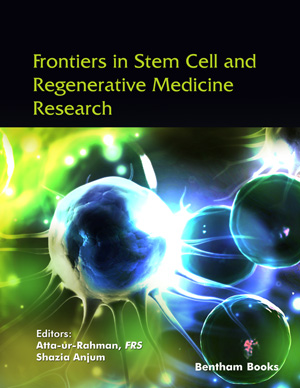
Abstract
Background: Alzheimer's disease (AD) is a progressive neurodegenerative disease characterized by progressive cognitive deterioration. All recent therapeutic strategies tend to inhibit the generation of the Aβ peptide. These approaches tend to mediate both α - and γ -secretases to undergo the nonamyloidogenic pathway. ADAM10 is the main α-secretase that cleaves APP, and it is regulated by the metabolic product of vitamin A (retinoic acid), which is being widely used recently in AD research as a target for treatment. Mesenchymal stem cells (MSCs) are also used recently as a promising regenerative therapy for AD.
Objectives: The present study aimed to: (1) study the effect of MSCs with/without acitretin on the regulation of Adam10 gene expression in AlCl3-induced AD rat model, and (2) validate the hypothesis that AD is a time-dependent progressive disease that spreads spontaneously even after the stopping of exposure to AlCl3.
Methods: The experimental work has been designed to include three successive phases; AlCl3 induction phase (I), AlCl3 withdrawal phase (W), and therapeutic phase (T). Forty-five male albino Wistar rats were randomly divided into 2 main groups: the control (C) group (15 rats) and AD group (30 rats). The therapeutic potential of MSCs with/without acitretin has been evaluated at behavioral, physiological, molecular, and histopathological levels.
Results: Among the three therapeutic groups, combined administration of both MSC and acitretin showed the best compensatory effects on most of the measured parameters.
Conclusion: The present study approved that AD is a time-dependent progressive disease which spreads spontaneously without more AlCl3 exposure.
Keywords: Alzheimer's disease, neurodegeneration, mesenchymal stem cells, acitretin, adam10, β-amyloid.
Graphical Abstract
[http://dx.doi.org/10.1016/j.febslet.2013.05.010] [PMID: 23684647]
[http://dx.doi.org/10.1038/s41598-020-72755-4] [PMID: 32968166]
[http://dx.doi.org/10.4103/ijp.IJP_545_19] [PMID: 33283771]
[http://dx.doi.org/10.1093/toxsci/kfi028] [PMID: 15537749]
[http://dx.doi.org/10.1007/s12026-013-8403-1] [PMID: 23609067]
[http://dx.doi.org/10.4155/fso.15.9] [PMID: 28031886]
[http://dx.doi.org/10.1038/nrneurol.2009.218] [PMID: 20139999]
[http://dx.doi.org/10.1007/s12017-009-8104-z] [PMID: 20232515]
[http://dx.doi.org/10.3390/ph11010012] [PMID: 29382156]
[http://dx.doi.org/10.1096/fj.08-121392] [PMID: 19144697]
[http://dx.doi.org/10.1371/journal.pone.0091003] [PMID: 24608847]
[http://dx.doi.org/10.3390/ijms151019226] [PMID: 25342318]
[http://dx.doi.org/10.1007/s11033-019-04983-5] [PMID: 31327120]
[http://dx.doi.org/10.1016/j.bbamcr.2018.01.005] [PMID: 29326073]
[http://dx.doi.org/10.1016/j.stemcr.2018.04.024] [PMID: 29805108]
[http://dx.doi.org/10.1007/s11064-015-1525-1] [PMID: 25630717]
[http://dx.doi.org/10.1016/j.seizure.2017.09.015] [PMID: 28957723]
[http://dx.doi.org/10.1038/nprot.2006.2] [PMID: 17406205]
[http://dx.doi.org/10.2147/IJN.S192382] [PMID: 30936694]
[http://dx.doi.org/10.1038/s41598-019-57252-7] [PMID: 31942001]
[http://dx.doi.org/10.1016/j.biopha.2017.05.022] [PMID: 28514831]
[http://dx.doi.org/10.5607/en.2014.23.1.45] [PMID: 24737939]
[http://dx.doi.org/10.5772/intechopen.85096]
[http://dx.doi.org/10.1073/pnas.0508945102] [PMID: 16330757]
[http://dx.doi.org/10.1016/j.neuint.2011.06.008] [PMID: 21718735]
[http://dx.doi.org/10.3727/096368913X672181] [PMID: 24070198]
[http://dx.doi.org/10.2217/rme-2016-0032] [PMID: 27582416]
[http://dx.doi.org/10.1517/14656566.6.10.1725] [PMID: 16086658]
[http://dx.doi.org/10.1172/JCI20864] [PMID: 15146243]
[http://dx.doi.org/10.1191/0748233706th242oa] [PMID: 16572710]
[http://dx.doi.org/10.3389/fnagi.2018.00244] [PMID: 30150930]
[http://dx.doi.org/10.1093/toxsci/kfq114] [PMID: 20395307]
[http://dx.doi.org/10.1186/1476-511X-11-16] [PMID: 22280491]
[http://dx.doi.org/10.1016/j.ijdevneu.2013.07.006] [PMID: 23933390]
[http://dx.doi.org/10.1111/jphp.12126] [PMID: 24236984]
[http://dx.doi.org/10.1016/j.joad.2016.08.028]
[http://dx.doi.org/10.1002/gps.1260] [PMID: 15660410]
[http://dx.doi.org/10.3945/jn.108.102988] [PMID: 19193816]
[http://dx.doi.org/10.1038/nrn.2015.8] [PMID: 26675822]
[http://dx.doi.org/10.1038/nrn.2016.102] [PMID: 27466142]
[http://dx.doi.org/10.1016/j.anbehav.2018.01.018]
[http://dx.doi.org/10.1159/000095640] [PMID: 16954693]
[http://dx.doi.org/10.1007/s12035-014-9051-8] [PMID: 25526861]
[http://dx.doi.org/10.2217/rme.15.17] [PMID: 26022763]
[http://dx.doi.org/10.3389/fnagi.2019.00182] [PMID: 31396076]
[http://dx.doi.org/10.1016/j.pnpbp.2012.09.012] [PMID: 23044340]
[http://dx.doi.org/10.1016/j.jneuroim.2016.10.004] [PMID: 27806872]
[http://dx.doi.org/10.1038/sj.npp.1300998] [PMID: 16395305]
[http://dx.doi.org/10.1111/ejn.12142] [PMID: 23379615]
[http://dx.doi.org/10.1523/JNEUROSCI.21-16-06423.2001] [PMID: 11487666]
[http://dx.doi.org/10.1016/S0955-2863(99)00066-2] [PMID: 15539337]
[PMID: 20424305]
[http://dx.doi.org/10.1073/pnas.0306336101] [PMID: 15051884]
[http://dx.doi.org/10.1038/nrn2212] [PMID: 17882253]
[http://dx.doi.org/10.1371/journal.pone.0003487] [PMID: 18941534]
[http://dx.doi.org/10.3233/JAD-142730] [PMID: 25589722]
[http://dx.doi.org/10.1007/s11064-014-1317-z] [PMID: 24792732]
[http://dx.doi.org/10.1016/j.jmb.2009.12.016] [PMID: 20026079]
[http://dx.doi.org/10.1016/j.neurobiolaging.2015.12.008] [PMID: 26973100]
[http://dx.doi.org/10.15252/emmm.201606210] [PMID: 27025652]
[http://dx.doi.org/10.1096/fj.02-0012fje] [PMID: 12039845]
[http://dx.doi.org/10.1016/j.jinorgbio.2009.07.023] [PMID: 19744735]
[http://dx.doi.org/10.1016/j.neurobiolaging.2016.11.009] [PMID: 28056358]
[http://dx.doi.org/10.1016/j.bbr.2016.12.021] [PMID: 28007537]
[http://dx.doi.org/10.3233/JAD-132720] [PMID: 24916544]
[http://dx.doi.org/10.1016/j.arabjc.2015.06.019]
[http://dx.doi.org/10.4061/2011/276393] [PMID: 21423554]
[http://dx.doi.org/10.1016/S0169-328X(01)00256-X] [PMID: 11731006]
[http://dx.doi.org/10.1158/0008-5472.CAN-04-1129] [PMID: 15374966]
[http://dx.doi.org/10.1016/j.jcyt.2015.10.006] [PMID: 26719199]
[PMID: 30123990]
[http://dx.doi.org/10.1371/journal.pone.0163327] [PMID: 27706181]
[http://dx.doi.org/10.1371/journal.pone.0168859] [PMID: 28046000]
[http://dx.doi.org/10.1016/j.pbb.2014.02.016] [PMID: 24582848]
[http://dx.doi.org/10.1159/000435885] [PMID: 26278415]
[http://dx.doi.org/10.1371/journal.pone.0045757] [PMID: 23049854]
[http://dx.doi.org/10.1117/1.JBO.19.5.051206] [PMID: 24297061]
[http://dx.doi.org/10.1016/j.neurobiolaging.2006.06.003] [PMID: 16837104]
[PMID: 25337323]
[http://dx.doi.org/10.1007/s11357-009-9099-y] [PMID: 19468866]
[http://dx.doi.org/10.3389/fneur.2019.00399] [PMID: 31114535]
[http://dx.doi.org/10.1016/j.jinorgbio.2005.06.015] [PMID: 16055195]
[http://dx.doi.org/10.1016/j.jnutbio.2015.07.017] [PMID: 26411262]
[http://dx.doi.org/10.1038/nrn3228] [PMID: 22595785]
[http://dx.doi.org/10.1002/glia.10146] [PMID: 12379910]
[http://dx.doi.org/10.1155/2014/309129] [PMID: 25025046]
[http://dx.doi.org/10.1016/j.ejmech.2015.03.040] [PMID: 25812965]
[http://dx.doi.org/10.1016/j.biopha.2015.12.024] [PMID: 26898423]
[http://dx.doi.org/10.1002/jnr.23182] [PMID: 23404260]
[http://dx.doi.org/10.4161/auto.26508] [PMID: 24149893]
[http://dx.doi.org/10.1111/j.1524-475X.2009.00499.x] [PMID: 19614919]
[http://dx.doi.org/10.1038/srep01197] [PMID: 23378928]
[http://dx.doi.org/10.3390/ijms18010094] [PMID: 28067783]
[http://dx.doi.org/10.5812/thrita.99975]
[http://dx.doi.org/10.1002/glia.20153] [PMID: 15602748]
[http://dx.doi.org/10.1523/JNEUROSCI.3153-08.2008] [PMID: 18987198]
[http://dx.doi.org/10.3109/09546634.2012.697985] [PMID: 22646471]
[http://dx.doi.org/10.1007/s11255-018-1956-0] [PMID: 30117015]













